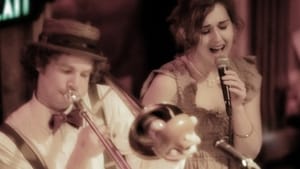Stay in the Loop
BSR publishes on a weekly schedule, with an email newsletter every Wednesday and Thursday morning. There’s no paywall, and subscribing is always free.
Where did New Orleans jazz go? To Philly!
Perseverance Jazz Band in Wallingford

When I first visited New Orleans nearly forty years ago, I was overwhelmed by the ubiquity of traditional jazz. Preservation Hall, which had been founded in the early '60s by Pennsylvania newlyweds Allan and Sandra Jaffe, still featured some of the originators of the music, and Al Hirt and Pete Fountain performed regularly in the French Quarter clubs bearing their names. I spent numerous hours at the Maison Bourbon listening to the house band led by trumpeter Thomas Jefferson, and I even saw the seven-year-old Harry Connick Jr. (whose father was then the local district attorney) sit in. The Maison Bourbon was one of four jazz venues at the corner of Bourbon and St. Peter Streets, and all of them would blare their musical product out into the busy intersection (Preservation Hall was just down St. Peter).
After an absence of over three decades, I returned to the post-Katrina Big Easy in 2011, and while the city has largely recovered from the extensive damage wrought by the hurricane, the traditional jazz that I enjoyed the first time around appears to have been a casualty. While the Maison Bourbon is still a jazz venue, it now features music more typical of New York’s 52nd St. during the bebop heyday in the '40s and '50s, and the adjacent clubs, like most in the Quarter, now present zydeco, blues, and hard rock.
Even the annual New Orleans Jazz & Heritage Festival, which was launched in the early '70s by Newport Jazz and Newport Folk Festival founder George Wein, resembles Woodstock more than any jazz fete with which I am familiar (Bruce Springsteen, whose only connection with jazz was probably the late saxophonist Clarence Clemons, was a recent headliner). Only Preservation Hall, now run by tubist Ben Jaffe (the founders' son), appears to live up to its name, although the musicians are much younger than their predecessors. Some remnants of the classic jazz can also be found on Frenchmen Street, which lies north of the Quarter.
New Orleans is no stranger to musical diasporas, the first of which followed the First World War, when the prohibitionist secretary of the navy Josephus Daniels shut down Storyville, which employed numerous musicians of color (Daniels regarded Storyville as a source of moral turpitude among sailors). Musical talents like Jelly Roll Morton, Joe “King” Oliver, and the young Louis Armstrong fanned out to Chicago, New York, and other American cities. Eighty-eight years later, Hurricane Katrina was responsible for another musical diaspora, and this time Philadelphia was one of the beneficiaries.
Among the premier traditional New Orleans-styled, Philly-based jazz ensembles is the Perseverance Jazz Band, which was formed by bassist Jonathan Davenport and vocalist Cecilia Ferneborg several years ago. This band of 20- and 30-somethings has benefited from the presence of veteran reed man Dr. Bob Rawlins, who is a professor of music theory at Glassboro’s Rowan University. This was the PJB’s debut for the Tri-State Jazz Society, which presents monthly Sunday concerts alternating between Wallingford, PA and Haddonfield, NJ.
A flying start
“South Rampart Street Parade”, which was actually a 1930s big band opus composed by bassist Bob Haggart for the Bob Crosby (Bing’s kid brother) aggregation, got the PJB off to a flying start. From there on, the band took the audience on a musical tour of the Big Easy, with occasional detours to Harlem (Fats Waller’s “I’m Crazy 'Bout My Baby” and “I’m Gonna Sit Write Down and Write Myself a Letter”) and Roaring '20s Chicago (to which many New Orleans musician-exiles contributed), represented here by Jean Goldkette’s “My Pretty Girl.” Ms. Ferneborg’s vocals combined Ella Fitzgerald’s scat with Louis Armstrong’s phrasing, delivered in a voice reminiscent of Helen Humes, who succeeded Billie Holiday as Count Basie’s female vocalist in the late '30s. Co-founder Davenport displayed his vocal talents on “Letter” and "After You’ve Gone."
Brassmen Hershberger and Toft made their horns speak and growl through the use of a variety of mutes, some of which are seldom seen today but were once quite common. “Doctor Jazz” Rawlins provided Pete Fountain-inspired clarinet and an alto sax style that recalled Jimmy Dorsey. Streim’s piano contributed a Harlem stride groove throughout, with flashes of Thelonious Monk. Drummer Brown maintained authentic yet swinging Crescent City rhythms throughout, culminating in the '20s classic “The Sheik of Araby” (inspired by silent film idol Rudolph Valentino and revived in the '50s by New Orleans native Louis Prima, who added the line “with no pants on,” which was sung as a refrain here by the entire band).
The PJB’s only drawback on this gig was the absence of a banjo, which has appeared with them at other performances and on their CD Hard Times Come Again No More. In all other respects, traditional New Orleans jazz survives and flourishes some 1,300 miles to the northeast of its birthplace with the Perseverance Jazz Band and other Philly-based ensembles.
What, When, Where
Perseverance Jazz Band. Jonathan Davenport, bass and vocals; Cecilia Ferneborg, vocals; Adam Hershberger, trumpet; Larry Toft, trombone; Bob Rawlins, clarinet and alto sax; David Streim, piano; Chad Brown, drums. Tri-State Jazz Society, Community Arts Center, 414 Plush Road, Wallingford, PA, on July 20, 2014. http://www.perseverancemusic.com
Sign up for our newsletter
All of the week's new articles, all in one place. Sign up for the free weekly BSR newsletters, and don't miss a conversation.

 Robert J. Robbins
Robert J. Robbins